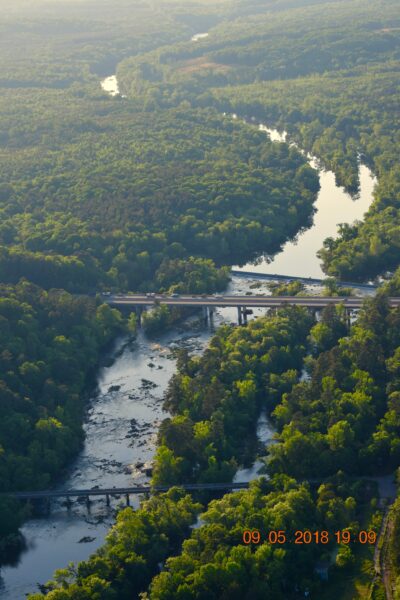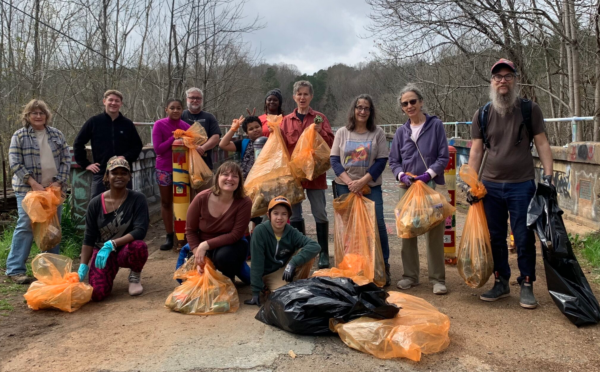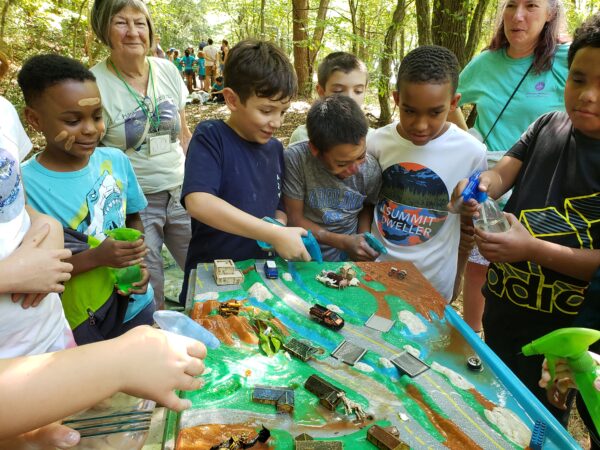 “Our goal is to serve everyone. Obviously, everyone needs clean water.”
“Our goal is to serve everyone. Obviously, everyone needs clean water.”
-Elaine Chiosso, Executive Director, Haw River Assembly
 Forty years ago, community members came together in hopes of saving their beloved Haw River. The building of the Jordan Lake Dam was on the horizon and would forever change the river that was central to the community. The threatening effects of the dam were obvious, from flooded land to pollution, and the immeasurable frustration and heartbreak this pending development would cause the community was palpable.
Forty years ago, community members came together in hopes of saving their beloved Haw River. The building of the Jordan Lake Dam was on the horizon and would forever change the river that was central to the community. The threatening effects of the dam were obvious, from flooded land to pollution, and the immeasurable frustration and heartbreak this pending development would cause the community was palpable.
While joint efforts resulted in a building delay, the battle was lost, and the dam was built. While organizers were crushed by the decision, the experience provided valuable insights that helped continue the fight for protection of the river in other ways. 150 passionate community members had been mobilized over the issue and would ultimately become the river’s voice through the creation of the Haw River Assembly (HRA).
Two especially passionate members of the group were graduate students at the University of North Carolina Chapel Hill, Lynn Featherstone and Chuck Brady, who were instrumental in the formation and success of HRA. Featherstone continues to serve on the Board of Directors today. Brady’s career highlights included Navy flight surgeon as well as NASA astronaut, member of a 1997 space shuttle mission. Though Brady passed away in 2006, his legacy lives on.
 One of the most difficult realities that HRA faces is that advocacy is often an excruciatingly slow process. In 1985, a massive study was completed on industrial contaminants found in the Haw River. Towns stretching from Pittsboro to even those alongside the Deep and Cape Fear Rivers were directly in harm’s way, as the river was their source of water. Hazardous chemicals were found from the study, however zero action was taken by local or state government.
One of the most difficult realities that HRA faces is that advocacy is often an excruciatingly slow process. In 1985, a massive study was completed on industrial contaminants found in the Haw River. Towns stretching from Pittsboro to even those alongside the Deep and Cape Fear Rivers were directly in harm’s way, as the river was their source of water. Hazardous chemicals were found from the study, however zero action was taken by local or state government.
 Fast forward to 2012, when progress finally was made after HRA partnered with researchers at the University of North Carolina and concerns were raised about what was found in the solids removed from wastewater treatment plants, commonly referred to as “sludge.” Further studies with scientists from North Carolina State University, Duke University and Research Triangle Park’s Environmental Protection Agency found that the Haw River was a hot spot for “PFAS” chemicals and 1,4-dioxane. “PFAS” or “forever chemicals” are often used for water, fire and stain-proofing but are dangerous in a river that many use as their direct source of drinking water. Up until this point, there had been no forcible standards present to mitigate the hazardous conditions these chemicals were causing. While state legislation has yet to be passed, litigation HRA brought against Burlington and Greensboro resulted in both cities agreeing to investigate and stop industrial sources of pollution. The fight against fracking in North Carolina and the battle to slow down the development of Chatham Park are two additional examples of HRA work that highlight how this work does not happen overnight.
Fast forward to 2012, when progress finally was made after HRA partnered with researchers at the University of North Carolina and concerns were raised about what was found in the solids removed from wastewater treatment plants, commonly referred to as “sludge.” Further studies with scientists from North Carolina State University, Duke University and Research Triangle Park’s Environmental Protection Agency found that the Haw River was a hot spot for “PFAS” chemicals and 1,4-dioxane. “PFAS” or “forever chemicals” are often used for water, fire and stain-proofing but are dangerous in a river that many use as their direct source of drinking water. Up until this point, there had been no forcible standards present to mitigate the hazardous conditions these chemicals were causing. While state legislation has yet to be passed, litigation HRA brought against Burlington and Greensboro resulted in both cities agreeing to investigate and stop industrial sources of pollution. The fight against fracking in North Carolina and the battle to slow down the development of Chatham Park are two additional examples of HRA work that highlight how this work does not happen overnight.
 Environmental advocacy is a slow process that can oftentimes lead to burn out, which is why it was important to develop fun and educational programs for the community as an integral part of HRA. Programs offered are suitable for families and encourage youth to take part in this important work. With approximately 500 total volunteers, the organization hosts an annual Haw River clean-up, the River Watch Project, the Haw River Learning Celebration, and an annual festival each May. While these programs contribute to the work and protection of the Haw River, Elaine describes how rejuvenating they are both for staff and the community at large, reminding people just how amazing the river is.
Environmental advocacy is a slow process that can oftentimes lead to burn out, which is why it was important to develop fun and educational programs for the community as an integral part of HRA. Programs offered are suitable for families and encourage youth to take part in this important work. With approximately 500 total volunteers, the organization hosts an annual Haw River clean-up, the River Watch Project, the Haw River Learning Celebration, and an annual festival each May. While these programs contribute to the work and protection of the Haw River, Elaine describes how rejuvenating they are both for staff and the community at large, reminding people just how amazing the river is.
 When asked about the future of HRA, Elaine said it was difficult to provide a detailed roadmap for the future as circumstances are always changing, but there are a few things on her wish list. Over the years, and especially since the pandemic, more people have developed an affinity for nature, and alongside the population growth in the region, Elaine would like to see more land purchased along the river to create more parks. Additionally, she would like to increase staff size with a competitive salary and benefits package and increase outreach and communication to the public to grow a larger watershed community concerned about water pollution. She is certain the organization will continue its commitment to environmental justice moving forward, as environmental burdens affect communities differently depending on available resources they have to fight back. “There are always new pollution threats and we have to be ever vigilant for whatever is going to happen next,” she says. “Clean water is a basic human right."
When asked about the future of HRA, Elaine said it was difficult to provide a detailed roadmap for the future as circumstances are always changing, but there are a few things on her wish list. Over the years, and especially since the pandemic, more people have developed an affinity for nature, and alongside the population growth in the region, Elaine would like to see more land purchased along the river to create more parks. Additionally, she would like to increase staff size with a competitive salary and benefits package and increase outreach and communication to the public to grow a larger watershed community concerned about water pollution. She is certain the organization will continue its commitment to environmental justice moving forward, as environmental burdens affect communities differently depending on available resources they have to fight back. “There are always new pollution threats and we have to be ever vigilant for whatever is going to happen next,” she says. “Clean water is a basic human right."

Background: The Haw River Assembly was founded in 1982 as a nonprofit organization, to protect the Haw River and Jordan Lake, and to build a watershed community to support that effort. There are eight counties that are part of the Haw River watershed: Guilford, Rockingham, Caswell, Alamance, Orange, Chatham, Durham, and western Wake.
Mission: To promote environmental awareness, conservation, and pollution prevention; to speak as a voice for the river in the public arena; and to put into peoples’ hands the tools and the knowledge they need to be effective guardians of the river. Our Haw Riverkeeper advocates for clean water, and against threats to the river.
Primary service area (county): Orange, Chatham, Durham, Wake
To learn more about Haw River Assembly, please visit their website below.
